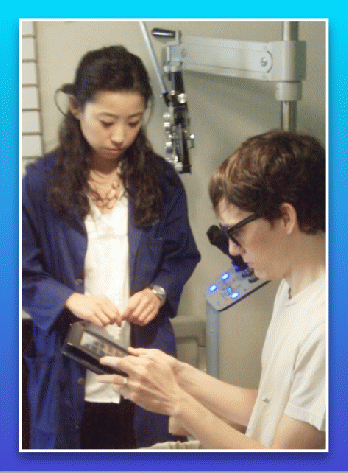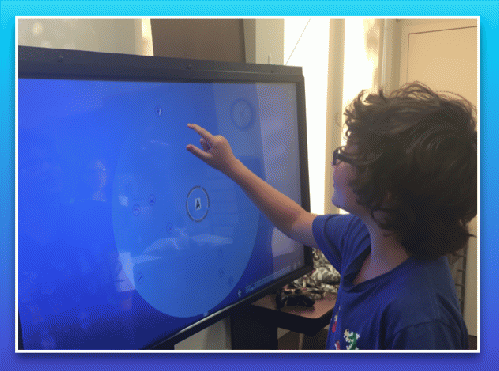We find that when eyes and ears are not working as a team, problems arise in processing the environment, which includes reading. Sometimes, the eyes and ears are synchronized, but the connection is fragile, meaning it is easily disrupted. Individuals with such connective fragility either must study in total silence, because they are unable to filter out background noises, or they study with background noise, because their minds wander when they cannot hear any other extraneous sounds in their environment.
The brain uses environmental clues to assess where objects are located. Those clues from the sensory systems, such as eyes and ears, need to coordinate. Therefore, it is essential for the eyes and ears to communicate. If eyes and ears don't interact well, the environment becomes scary and people often avoid it. For instance, we have an autistic patient who would always cling to his mother or stay on the floor, not wanting to go anywhere. After receiving his first pair of eyeglasses, he ran around and enjoyed going outdoors. His central eyesight was 20/20, yet he still needed glasses for his peripheral eyesight.
Another example of orienting to the environment was a blind student I remember from college, whose friends enjoyed tricking him by moving the audio speakers around in their dormitory room. When the blind student visited his friends' dorm room, he would stumble, because he had to re-orient himself to the speakers' new locations; his motor planning was based on expectations, which, in turn, were based on previous experiences. His ears could easily orient him to surroundings, but not when the sound sources were moved around.
The concussion patients we evaluate are out of sync very frequently. The analogy is like that of an orchestra playing poorly. Something is wrong with the music, yet each instrument and musician are fine on their own. If the conductor directs the cellos to play faster and the bassoons to play slower, all of a sudden the music sounds beautiful. They were out of sync and easily fixed. When we see patients who have been to different doctors, and each piece of them is fine yet they don't feel like themselves, we use eyeglasses to selectively speed up some signals and/or mute others, allowing them to regain efficient functioning.

Dr. Grace Yoon assessing the patient's depth perception ability
(Image by courtesy of Dr. Deborah Zelinsky) Details DMCA
JB: Your comments raise so many questions. Don't people function fairly well even without a stable eye-ear connection? Just needing to study in silence doesn't seem terribly disabling. Are there other, more serious ramifications from a less-than-stable eye-ear connection? And, how would people know they were suffering from that if that's all they've ever known?
DZ: Yes, there are more serious conditions. Adults and children who have unstable eye/ear connections are burdened with conscious, often confusing energy-draining decisions, that people with solid eye/ear connections make subconsciously and effortlessly. They are labeled as visual processing problems, or motivation problems or concentration or attention deficit disorder, etc. People can compensate by simply listening, while missing visual cues, such as body language and facial expressions. If people compensate by watching, they will be missing subtle cues of tone of voice and detailed nuances of words. Some people shift between listening and watching. This constant shifting creates fatigue, causing them to miss details, but comprehend the gist of a conversation or lecture. In school, however, testing is often about the details. People don't necessarily know they have a problem. They just tell me that they don't "get" the punchlines of jokes quickly, that they are not up to par with social skills, or that they find it too difficult to learn from a lecture unless they can read about the subject on their own.
JB: Your work has really caught on in Europe. I recently attended a seminar that you organized. Among the attendees were three optometrists from Austria, as well as all kinds of practitioners who were in some way integrating the mind-eye connection into their work. Why do you think optometrists in Europe have been so much faster to catch on to the value of your work?
DZ: I've taught in Spain, Belgium, France, Denmark, Greece, Austria, Germany, as well as in Canada and Australia. European optometry is different from American optometry; it is typically testing for clear eyesight, fitting contact lenses, and diagnosing diseases that must be referred to a medical specialist for follow-up. The medical doctors -- not the optometrists -- in Europe are primarily involved in eye health. Many optometrists in Europe realize that the eye does much more than simply see, and they have taken additional courses in such non-invasive visual processing subcategories as neuro-optometric rehabilitation. In America, optometrists are taught how to actually treat eye diseases -- not just diagnose them. We are considered physicians from an insurance company perspective and are able to write prescriptions, even for oral medications. The eye is looked at as an organ that sees, and assessments are not necessarily inclusive of brain processing.

Patient and Rotator: Graham tries to touch a target while it is rotating.
(Image by courtesy of Dr. Deborah Zelinsky) Details DMCA
JB: What about the other more local practitioners? Give us an idea of what they do and how they integrate mind-eye to enhance their work, please.
DZ: At this point, we are just beginning a program to certify doctors to integrate patented mind-eye concepts into their practices. The optometric part will be in Chicago this July, with information on our website about the upcoming Mind-Eye Campus. The basic point is that typical eye examinations for 20/20 testing emphasize the ability to see non-moving, high-contrast targets, such as dark letters on a white background. Testing is done while the patients are seated. In reality, academic and social environments, sports -- in fact, all of life -- require us to assess moving targets more quickly than stationary ones. We also have to use our eyes not only when the target is moving, but often times when we are moving as well.
Mind-eye testing evaluates all of these aspects. The certification program offers two tracks. One is for eye doctors to learn an updated way of prescribing for stability of the eye-ear connections and internal comfort; the other is for ancillary professionals to learn how to screen for the presence of eye-ear disconnections, and if need, refer to the appropriate Mind-Eye certified practitioner. Locally, our office (myself and Drs. Wright, Yoon and Nast) tests for eye/ear disconnections. Drs. Neil Margolis, Monica Spokas, Lindsey Stull and Ryan Edwards are involved in the certification process for evaluating eye-ear integration and synchronization. Our goal is to make people understand that 20/20 should be left in the twentieth century; it is an insufficient benchmark for visual processing. This new field of study is called neurophotonics. I have a chapter in the upcoming "Textbook of Neurophotonics and Brain Mapping", and a published case study in the Journal of Neurophotonics, showing a normalization of brainwaves once customized eyeglasses were worn.
JB: Your work has gained recognition due to the recent publication of The Brain's Way of Healing: Remarkable Discoveries and Recoveries from the Frontiers of Neuroplasticity. The author, Dr. Norman Doidge, is a well-respected psychiatrist, researcher and New York Times best-selling author of The Brain that Changes Itself, a fascinating read, which has sold more than 1,000,000 copies to date. Dr. Doidge mentions your work in the afterword of his latest book. That must have been gratifying. What did he have to say about what you do?
DZ: Yes, I had the once-in-a-lifetime chance to meet Dr. Doidge for dinner and a marvelous discussion regarding theories on brain function. I agree with his philosophy and greatly admire his work.
Norman Doidge, M.D. is a consummate professional whose words so aptly explain what the Mind-Eye Connection does. He states, "Optometry can also be used to rewire the brain...Optical lenses can alter sensory filtering...influencing brain activity that regulates body chemistry, sensory integration and even some auditory processing."
(Note: You can view every article as one long page if you sign up as an Advocate Member, or higher).





